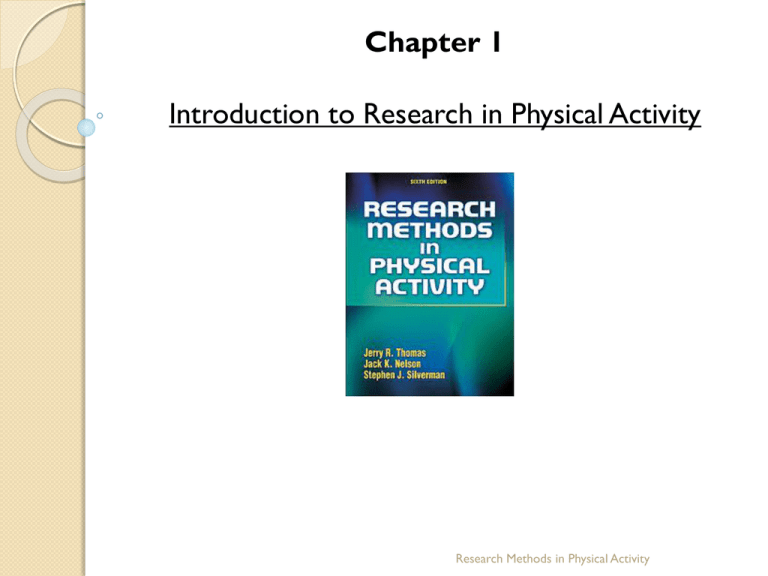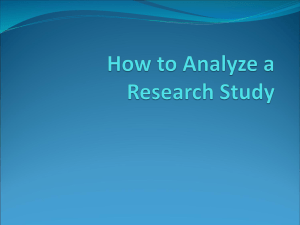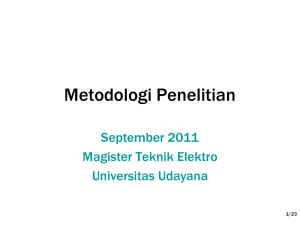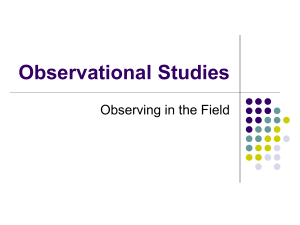PPT 01
advertisement

Chapter 1 Introduction to Research in Physical Activity Research Methods in Physical Activity The object of research is to determine how things are as compared to how they might be. To achieve this, research implies a careful and systematic means of solving problems and involves five characteristics (Tuckman, 1978). ♦Systematic. Problem solving is accomplished through the identification and labeling of variables and is followed by the design of research that tests the relationships among these variables. Data are then collected that, when related to the variables, allow the evaluation of the problem and hypotheses. ♦Logical. Examination of the procedures used in the research process allows researchers to evaluate the conclusions drawn. ♦Empirical. The researcher collects data on which to base decisions. ♦Reductive. The researcher takes individual events (data) and uses them to establish general relationships. ♦Replicable. The research process is recorded, enabling others to test the findings by repeating the research or to build future research on previous results. Research Methods in Physical Activity Research Continuum Research in our field can be placed on a continuum that has applied research at one extreme and basic research at the opposite extreme. Applied research —Type of research that has direct value to practitioners but in which the researcher has limited control over the research setting. Basic research —Type of research that may have limited direct application but in which the researcher has careful control of the conditions. Basic research and applied research can be thought of as two ends of a continuum. Basic research addresses theoretical problems, often in laboratory settings, and may have limited direct application. Applied research addresses immediate problems, often in less controlled real-world settings, and is more closely linked to application. Example - Applied research tends to address immediate problems, to use socalled real-world settings, to use human participants, to have limited control over the research setting, but to give results that are of direct value to practitioners. At the other extreme, basic research usually deals with theoretical problems. It uses the laboratory as the setting, frequently uses animals as subjects, carefully controls conditions, and produces results that have limited direct application. Research Methods in Physical Activity Example - Applied research tends to address immediate problems, to use so-called real-world settings, to use human participants, to have limited control over the research setting, but to give results that are of direct value to practitioners. At the other extreme, basic research usually deals with theoretical problems. It uses the laboratory as the setting, frequently uses animals as subjects, carefully controls conditions, and produces results that have limited direct application. Basic and applied forms of research are useful in informing each other as to future research directions….. (see Table1.1, page 5, text) Research Methods in Physical Activity To some extent, the strengths of applied research are the weaknesses of basic research, and vice versa. So should research be basic or applied? This issue, labeled ecological validity (the extent to which research emulates the real world), deals with two concerns: 1) Is the research setting perceived by the research participant in the way intended by the experimenter? 2) Does the setting have enough of the real-world characteristics to allow generalizing to reality? …. Of course, most research is neither purely applied nor purely basic; rather, it incorporates some degree of both. In both types of research there are tools required to produce and interpret research. These tools are called “Research Methods” Research Methods in Physical Activity Quality research efforts always involve some or all of the following components: ♦Identification and delimitation of a problem ♦Searching, reviewing, and effectively writing about relevant literature ♦Specifying and defining testable hypotheses ♦Designing the research to test the hypotheses ♦Selecting, describing, testing, and treating the participants ♦Analyzing and reporting the results ♦Discussing the meaning and implications of the findings Research Methods in Physical Activity Practicality and accessibility In an informative yet entertaining book on writing scientific papers, Day (1983) related the story about two men riding in a hot-air balloon who encountered some cloud coverage and lost their way. When they finally descended, they did not recognize the terrain and had not the faintest idea where they were. It so happened that they were drifting over the grounds of one of our more famous scientific research institutes. When the balloonists saw a man walking alongside a road, one of them called out, “Hey, mister, where are we?” The man looked up, took in the situation, and after a few moments of reflection said, “You’re in a hot-air balloon.” One balloonist turned to the other and said, “I’ll bet that man is a researcher.” The other balloonist asked, “What makes you think so?” The first replied, “His answer is perfectly accurate and totally useless” If we read and understand, we can implement (use research as a tool) and help others. Research Methods in Physical Activity Reading research If you are not knowledgeable about the subject matter, you cannot read the research literature. Conversely, if you know the subject matter, you can probably wade through the researcher’s jargon more effectively. For example, if you know baseball and the researcher is recommending that by shortening the radius, the hitter can increase the angular velocity, you can figure out that the researcher means to choke up on the bat. You must have a good foundation of knowledge so you can speak and comprehend the language of your profession. Research Methods in Physical Activity Reading research Guidelines: ♦Become familiar with a few publications that contain pertinent research in your field.You might get some help on choosing the publications from a professor or librarian. ♦Read only studies that are of interest to you. That point may sound too trite to mention, but some people feel obligated to wade through every article. ♦Read it as a practitioner would. Do not look for eternal truths. Look for ideas and indications. No study is proof of anything. Only when it has been verified repeatedly does it constitute knowledge. ♦Read the abstract first. This approach saves time by helping you determine whether you wish to read the whole thing. If you are still interested, then you can read the study to gain better understanding of the methodology and the interpretations, but do not get bogged down with details. Research Methods in Physical Activity Reading research Guidelines: ♦ Do not be too concerned about statistical significance. …..Understanding the concept of significance certainly helps, but a little common sense serves you about as well as knowing the difference between the .02 and the .01 levels, or a one-tailed test versus a two-tailed test. Think in terms of meaningfulness. For example, if two methods of teaching bowling result in an average difference of 0.5 pins, what does it matter whether the difference is significant? On the other hand, if a big difference is present but not significant, further investigation is warranted, especially if the study involved a small number of participants. Knowing the concepts of the different types of statistical analysis is certainly helpful, but it is not crucial to being able to read a study. Just skip that part. Research Methods in Physical Activity Reading research Guidelines: ♦ Be critical but objective. You can usually assume that a national research journal selects studies for publication by the jury method. Two or three qualified individuals read and judge the relevance of the problem, the validity and reliability of the procedures, the efficacy of the experimental design, and the appropriateness of the statistical analysis. Certainly, some studies are published that should not be.Yet if you are not an expert in research, you do not need to be suspicious about the scientific worth of a study that appears in a recognized journal. If it is too far removed from any practical application to your situation, do not read it. Research Methods in Physical Activity UNSCIENTIFIC VERSUS SCIENTIFIC METHODS OF PROBLEM SOLVING Research is concerned with problem solving, which then may lead to new knowledge. The problem-solving process involves several steps whereby the problem is developed, defined, and delimited; hypotheses are formulated; data are gathered and analyzed; and the results are interpreted with regard to the acceptance or rejection of the hypotheses. These steps are often referred to as the scientific method of problem solving. Unscientific Methods of Problem Solving The methods are tenacity, intuition, authority, the rationalistic method, and the empirical method. Tenacity: People sometimes cling to certain beliefs despite the lack of supporting evidence. Our superstitions are good examples of the method called tenacity. Research Methods in Physical Activity Unscientific Methods of Problem Solving Intuition: Intuitive knowledge is sometimes considered to be common sense or self-evident. Many self-evident truths, however, are subsequently found to be false. One fundamental tenet of science is that we must be ever cognizant of the importance of substantiating our convictions with factual evidence. Authority: Reference to some authority has long been used as a source of knowledge. Although this approach is not necessarily invalid, it does depend on the authority and on the rigidity of adherence. Perhaps the most crucial aspect of the appeal to authority as a means of obtaining knowledge is the right to question and to accept or reject the information. Furthermore, the authority’s qualifications and the methods by which the authority acquired the knowledge also determine the validity of this source of information. Research Methods in Physical Activity Unscientific Methods of Problem Solving Rationalistic: Method In the rationalistic method, we derive knowledge through reasoning. A good example is the following classic syllogism: All men are mortal (major premise). The emperor is a man (minor premise). Therefore, the emperor is mortal (conclusion). Although you probably would not argue with this reasoning, the key to this method is the truth of the premises and their relationship to each other. For example, Basketball players are tall. Tom Thumb is a basketball player. Therefore, Tom Thumb is tall. The conclusion is trustworthy only if it is derived from premises (assumptions) that are true. Also, the premises may not in fact be premises but rather descriptions of events or statements of fact. The statements are not connected in a cause-and-effect manner. Reasoning is fundamental in the scientific method of problem solving but cannot be used by itself to arrive at knowledge. Research Methods in Physical Activity Unscientific Methods of Problem Solving Empirical Method : The word empirical (Describes data or a study that is based on objective observations. )denotes experience and the gathering of data. Certainly, data gathering is part of the scientific method of solving problems. But relying too much on your own experience (or data) has drawbacks. • First, your own experience is limited. • Furthermore, your retention depends substantially on how the events agree with your experience and beliefs, on whether things “make sense,” and on your state of motivation to remember. Nevertheless, the use of data (and the empirical method) is high on the continuum of methods of obtaining knowledge as long as you are aware of the limitations of relying too heavily on this method. Research Methods in Physical Activity Scientific Methods of Problem Solving Step 1: Developing the Problem (Defining and Delimiting It) To design and execute a sound investigation, the researcher must be specific about what is to be studied and to what extent it will be studied. Many ramifications constitute this step, an important one being the identification of the independent variable and the dependent variables. The independent variable is what the researcher is manipulating, and this item is sometimes called the experimental, or treatment, variable. The dependent variable (also called the yield) is the effect of the independent variable. If you think of an experiment as a cause-and-effect proposition, the cause is the independent variable and the effect is the dependent variable. Thus, the researcher must define exactly what will be studied and what will be the measured effect. When this question is resolved, the experimental design can be determined. Research Methods in Physical Activity Scientific Methods of Problem Solving Step 2: Formulating the Hypothesis The hypothesis is the expected result. When a person sets out to conduct a study, he or she generally has an idea as to what the outcome will be. This anticipated solution to the problem may be based on some theoretical construct, on the results of previous studies, or perhaps on the experimenter’s experience and observations. One of the essential features about the hypothesis is that it be testable. The study must be designed in such a way that the hypothesis can be either supported or refuted. Obviously, then, the hypothesis cannot be a type of value judgment or an abstract phenomenon that cannot be observed. Research Methods in Physical Activity Scientific Methods of Problem Solving Step 3: Gathering the Data The researcher must decide on the proper methods of acquiring the necessary data to be used in testing the research hypothesis. The reliability of the measuring instruments, the controls that are employed, and the overall objectivity and precision of the data-gathering process are crucial to solving the problem. Planning the method, however, is one of the most difficult steps. Good methods attempt to maximize both the internal validity and the external validity of the study. Internal validity —The extent to which the results of a study can be attributed to the treatments used in the study. Internal validity refers to the extent to which the results can be attributed to the treatments used in the study. In other words, the researcher must try to control all other variables that could influence the results. External validity —The generalizability of the results of a study. o what extent can the results apply to the real world? Research Methods in Physical Activity Planning the method, however, is one of the most difficult steps. Good methods attempt to maximize both the internal validity and the external validity of the study. Internal vs. External Validity Research Methods in Physical Activity Step 4: Analyzing and Interpreting Results • This step usually involves some statistical analysis. • Analysis and interpretation require considerable knowledge, experience, and insight. •The researcher must provide evidence for the support or rejection of the research hypothesis. In doing this, the researcher also compares the results with those of others (the related literature) and perhaps attempts to relate and integrate the results into some theoretical model. Inductive reasoning is employed in this step (whereas deductive reasoning is primarily used in the statement of the problem). The researcher attempts to synthesize the data, and to develop or substantiate a theory. Research Methods in Physical Activity Alternative Models of Research Normal science — An objective manner of study grounded in the natural sciences that is systematic, logical, empirical, reductive, and replicable. Normal science is grounded in the natural sciences, which have long adhered to the idea of the orderliness and reality of matter, that nature’s laws are absolute and discoverable by objective, systematic observations and investigations that are not influenced by (in other words, independent of) humans. The experiments are theory driven and have testable hypotheses. Challenges to Normal Science Relatively recently (since about 1960), serious challenges have arisen regarding normal science’s concept of objectivity (i.e., that the researcher can be detached from the instruments and conduct of the experiment). From the first inception of the idea for the hypothesis through the selection of apparatus to the analysis of the results, the observer is involved. Research Methods in Physical Activity Alternative Models of Research Challenges to Normal Science Normal science does not really evolve in systematic steps the way that scientific writers describe it. • The paradigm crisis (Development of discrepancies in a paradigm leading to proposals of a new paradigm that better explains the data.) phenomenon, in which researchers who have been following a particular paradigm begin to find discrepancies in it. •The findings no longer agree with the predictions, and a new paradigm is advanced. Interestingly, the old paradigm does not die completely but only develops varicose veins and fades away. Many researchers with a great deal of time and effort invested in the old paradigm are reluctant to change, so it is usually a new group of researchers who propose the new paradigm. •Thus, normal science progresses by revolution, with a new group of scientists breaking away and replacing the old. Research Methods in Physical Activity Alternative Models of Research Challenges to Normal Science Normal Science has been challenged with Qualitative Research. Qualitative Research: Research method that often involves intensive, long-time observation in a natural setting; precise and detailed recording of what happens in the setting; interpretation and analysis of the data using description, narratives, quotes, charts, and tables. Also called ethnographic, naturalistic, interpretive, grounded, phenomenological, subjective, and participant observational. The naturalistic setting of qualitative research both facilitates analysis and precludes precise control of so-called extraneous factors, as does much other research occurring in field settings. The holistic interrelationship among observations and the complexity and dynamic processes of human interaction make it impossible to limit the study of human behavior to the sterile, reductionistic approach of normal science. Reductionism, a characteristic of normal science, assumes that complex behavior can be reduced, analyzed, and explained as parts that can then be put back together as a whole and understood. Critics of the conventional approach to research believe that the central issue is the unjustified belief that normal science is the only source of true knowledge. Research Methods in Physical Activity Types of Research Analytical Research : As the name implies, analytical research involves indepth study and evaluation of available information in an attempt to explain complex phenomena. The different types of analytical research are historical, philosophic, reviews, and research synthesis. Historical Research : Obviously, historical research deals with events that have already occurred. Historical research focuses on events, organizations, institutions, and people. Philosophic Research : Critical inquiry characterizes philosophic research. The researcher establishes hypotheses, examines and analyzes existing facts, and synthesizes the evidence into a workable theoretical model. Many of the most important problem areas must be dealt with by the philosophic method. . Problems dealing with objectives, curricula, course content, requirements, and methodology are but a few of the important issues that can be resolved only through the philosophic method of problem Research Methods in Physical Activity solving. Types of Research Reviews : A review is a critical evaluation of recent research on a particular topic. The author must be extremely knowledgeable about the available literature as well as the research topic and procedures. A review involves analysis, evaluation, and integration of the published literature, often leading to important conclusions concerning the research findings up to that time Research Synthesis : Reviews of literature are difficult to write because they require that a large number of studies be synthesized to determine common underlying findings, agreements, or disagreements. To some extent this is like trying to make sense of data collected on a large number of participants by simply looking at the data. A quantitative means of analyzing the findings from numerous studies is called a meta-analysis. Research Methods in Physical Activity Descriptive Research Descriptive research : A type of research that attempts to describe the status of the study’s focus. Common techniques are questionnaires, interviews, normative surveys, case studies, job analyses, observational research, developmental studies, and correlation studies. Three different types of survey research techniques: 1. Questionnaire : The main justification for using a questionnaire is the need to obtain responses from people, often from a wide geographical area. The questionnaire usually strives to secure information about present practices, conditions, and demographic data. Occasionally, a questionnaire asks for opinions or knowledge. 2. Interview : The interview and the questionnaire are essentially the same technique insofar as planning and procedures are concerned. Obviously, the interview has certain advantages over the questionnaire. The researcher can rephrase questions and ask additional ones to clarify responses and secure results that are more valid. Research Methods in Physical Activity Three different types of survey research techniques (continued) : 3. Normative Survey : A number of notable normative surveys have been conducted in the fields of physical activity and health. The normative survey generally seeks to gather performance or knowledge data on a large sample from a population and to present the results in the form of comparative standards, or norms. Research Methods in Physical Activity Other Descriptive Research Techniques Case Study : The case study is used to provide detailed information about an individual (or institution, community, and so on). It aims to determine unique characteristics about the subject or condition. This descriptive research technique is used widely in such fields as medicine, psychology, counseling, and sociology. The case study is also a technique used in qualitative research. Job Analysis : This type of research is a special form of case study. It is done to describe the nature of a particular job, including the duties, responsibilities, and preparation required for success in the job. Observational Research : Observational research is a descriptive technique in which behaviors are observed in the participants’ natural setting, such as the classroom or play environment. Research Methods in Physical Activity Other Descriptive Research Techniques Developmental Studies : In developmental research, the investigator is usually concerned with the interaction of learning or performance with maturation. Developmental research can be undertaken by what is called the longitudinal method, whereby the same participants are studied over a period of years. Obvious logistical problems are associated with longitudinal studies, so an alternative is to select samples of participants from different age groups to assess the effects of maturation. This is called the cross-sectional approach. Research Methods in Physical Activity Other Descriptive Research Techniques Correlation Studies : The purpose of correlation research is to examine the relationship between variables. For example, a researcher may wish to predict percentage of body fat from skinfold measurements. Correlation research is descriptive in that you cannot presume a cause-and-effect relationship. All that can be established is that an association is (or is not) present between two or more traits or performances. Epidemiologic Research This type of research pertains to the frequencies and distributions of health and disease conditions among various populations. Rate of occurrence is the basic concept in epidemiologic studies. The size of the population being studied is an important consideration in examining the prevalence of such things as injuries, illnesses, or health conditions in a specified at-risk population. Although cause and effect cannot be established by incidence and prevalence data, a strong inference of causation can often be made through association. Research Methods in Physical Activity Experimental and Qualitative Research Experimental research has a major advantage over other types of research in that the researcher can manipulate treatments to cause things to happen (i.e., a cause-and-effect situation can be established). In experimental research, the researcher attempts to control all factors except the experimental (or treatment) variable. If the extraneous factors can be successfully controlled, then the researcher can presume that the changes in the dependent variable are due to the independent variable. Qualitative research : Qualitative research is different from other research methods. Qualitative research rarely establishes hypotheses at the beginning of the study, but instead uses more general questions to guide the study. It proceeds in an inductive process in developing hypotheses and theory as the data unfold. The researcher is the primary instrument in data collection and analysis. Qualitative research is characterized by intensive firsthand presence. The tools of data collection are observation, interviews, and researcher-designed instruments Research Methods in Physical Activity Mixed Methods or Mixed Models of Research In this approach both quantitative and qualitative approaches are included (or mixed) within a research effort. This approach, often viewed as a pragmatic one, suggests that both qualitative and quantitative techniques are useful when studying real-world phenomena. For mixed methods, qualitative and quantitative techniques are integrated, or mixed, within a single study. For mixed models, it is like two small studies, one quantitative and one qualitative. Research Methods in Physical Activity Overview of the Research Methods Research Methods in Physical Activity END OF PRESENTATION Research Methods in Physical Activity









